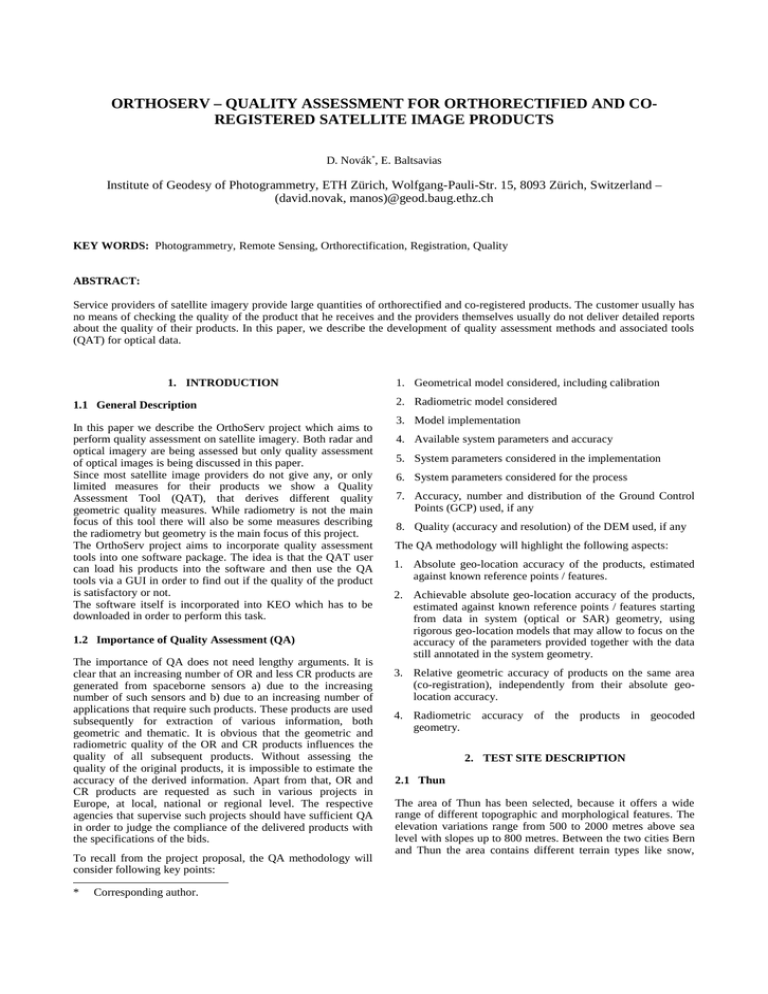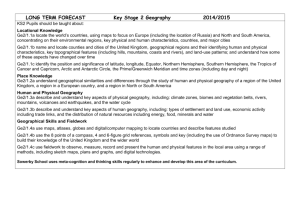ORTHOSERV – QUALITY ASSESSMENT FOR ORTHORECTIFIED AND CO-
advertisement

ORTHOSERV – QUALITY ASSESSMENT FOR ORTHORECTIFIED AND COREGISTERED SATELLITE IMAGE PRODUCTS D. Novák*, E. Baltsavias Institute of Geodesy of Photogrammetry, ETH Zürich, Wolfgang-Pauli-Str. 15, 8093 Zürich, Switzerland – (david.novak, manos)@geod.baug.ethz.ch KEY WORDS: Photogrammetry, Remote Sensing, Orthorectification, Registration, Quality ABSTRACT: Service providers of satellite imagery provide large quantities of orthorectified and co-registered products. The customer usually has no means of checking the quality of the product that he receives and the providers themselves usually do not deliver detailed reports about the quality of their products. In this paper, we describe the development of quality assessment methods and associated tools (QAT) for optical data. 1. INTRODUCTION 1.1 General Description In this paper we describe the OrthoServ project which aims to perform quality assessment on satellite imagery. Both radar and optical imagery are being assessed but only quality assessment of optical images is being discussed in this paper. Since most satellite image providers do not give any, or only limited measures for their products we show a Quality Assessment Tool (QAT), that derives different quality geometric quality measures. While radiometry is not the main focus of this tool there will also be some measures describing the radiometry but geometry is the main focus of this project. The OrthoServ project aims to incorporate quality assessment tools into one software package. The idea is that the QAT user can load his products into the software and then use the QA tools via a GUI in order to find out if the quality of the product is satisfactory or not. The software itself is incorporated into KEO which has to be downloaded in order to perform this task. 1.2 Importance of Quality Assessment (QA) The importance of QA does not need lengthy arguments. It is clear that an increasing number of OR and less CR products are generated from spaceborne sensors a) due to the increasing number of such sensors and b) due to an increasing number of applications that require such products. These products are used subsequently for extraction of various information, both geometric and thematic. It is obvious that the geometric and radiometric quality of the OR and CR products influences the quality of all subsequent products. Without assessing the quality of the original products, it is impossible to estimate the accuracy of the derived information. Apart from that, OR and CR products are requested as such in various projects in Europe, at local, national or regional level. The respective agencies that supervise such projects should have sufficient QA in order to judge the compliance of the delivered products with the specifications of the bids. To recall from the project proposal, the QA methodology will consider following key points: * Corresponding author. 1. Geometrical model considered, including calibration 2. Radiometric model considered 3. Model implementation 4. Available system parameters and accuracy 5. System parameters considered in the implementation 6. System parameters considered for the process 7. Accuracy, number and distribution of the Ground Control Points (GCP) used, if any 8. Quality (accuracy and resolution) of the DEM used, if any The QA methodology will highlight the following aspects: 1. Absolute geo-location accuracy of the products, estimated against known reference points / features. 2. Achievable absolute geo-location accuracy of the products, estimated against known reference points / features starting from data in system (optical or SAR) geometry, using rigorous geo-location models that may allow to focus on the accuracy of the parameters provided together with the data still annotated in the system geometry. 3. Relative geometric accuracy of products on the same area (co-registration), independently from their absolute geolocation accuracy. 4. Radiometric accuracy of the products in geocoded geometry. 2. TEST SITE DESCRIPTION 2.1 Thun The area of Thun has been selected, because it offers a wide range of different topographic and morphological features. The elevation variations range from 500 to 2000 metres above sea level with slopes up to 800 metres. Between the two cities Bern and Thun the area contains different terrain types like snow, bare rock, grass, acres, forest, different sized roads, two rivers and the lake of Thun as well as urban areas. 2.2 Mausanne-les-Alpilles Thun A further sample data set to be integrated in the RDS is centered on the town of Mausanne-les-Alpilles, France. The Institute for the Protection and Security of the Citizen IPSC at JRC has at its disposal an ‘Action CID’ (Community Image Data portal) that stores and serves satellite/aerial data to the EC Services. It has currently approximately 10 TB of data archived. Among them, a lot of data concerning the mentioned area. It presents a variety of agricultural conditions typical for the EU. The site contains a low mountain massif (elevation up to around 650m above sea level), mostly covered by forest, surrounded by low lying agricultural plains, a lot of olive groves. A number of small urban settlements of low density and a few limited water bodies are present over the site. Maus. For this project, several images from different sensors have been chosen over the two mentioned test sites.. Table 1 shows the distribution of the sensors over the two test sites: 1G L1A STD. L1B1 L1B Thun X X X X X X X Maus anne X Ik Prism IRS C; E C;D;E; B;C;D; F E C;D A;D;F A;D QB WV B;D B;D Table 2: Overview which providers processed which images For this paper only the data of Ikonos, Quickbird and Worldview was investigated thus only the data from providers B, C, D and E. Ikonos Quickbird WV-1 Res-Col 1m 0.6 m 0.5 m Res-Row 1m 0.6 m 0.5 m Ikonos IRS- Quick WV-1 P6 bird Level Spot Table 3: Received GSD's from the providers 3. DATA DESCRIPTION Land SPOT Ikono PRIS sat 7 -5 s M TM L2A X L2A Two datasets were available for Mausanne as well. The first DEM was derived from analogue photos in 1997 and has a resolution of 25 metres and an accuracy of 3 – 5 metres. The second DEM was derived from ADS-40 images and delivers a resolution of 2 metres and an accuracy of 10 cm. GCP's were made available both over Mausanne and Thun. For Thun a total of 138 GCP's are available which were measured using static DGPS. The average accuracy of the measurements is 0.8 cm. For Mausanne a total of 51 GCP's are available with an accuracy of 10 cm or less. 4. PROVIDERS A total of 6 satellite image service providers have participated in this project and delivered orthoimages for the different sensors and test sites. The providers itself will not be named, instead they will be named with 'A', 'B' and so on. Following is a list of which provider processed which images over what site: D E Not yet available RPC's + GCP's for bundle adjustment (shift) + Ikonos DEM RPC's + GCP's + DEM (no information about refinement etc. - RPC's + GCP's for bundle adjustment (affine) + Ikonos DEM - - RPC's + GCP's for bundle adjustment (shift) + Ikonos DEM - polynomial correction (shift) + GCP Heights Table 1: Data distribution over the two sites The second DEM was derived automatically from Ikonos images with software from our institute. Since it has been derived automatically, some blunders are still present. The accuracy of the DSM is around 1 metre in open areas, 3 metres in urban and 5 metres in wooded areas. The resolution of the Ikonos DEM is 5 metres. C RPC's + polynomial correction (shift) + GCP Heights Quickbird RPC's + X Additionally DEM's were supplied to each provider to make the results more comparable. In Thun the first DEM is the DHM25 from Swisstopo. The average accuracy of DHM25 ranges from 1.5 metres in flat areas to up to 3 metres in mountainous areas and has a resolution of 25 metres. B WV-1 RPC's + polynomial correction (shift) + GCP Heights Table 4: Used orientation methods by the providers 5. METHODOLOGY To assess the quality of the orthoimages the supplied GCP's are measured manually in the orthophotos and the coordinates compared with the original ones. A radiometric comparison is also done according to [Hanusch, Baltsavias 2009]. Additionally a qualitiative comparison is done visually especially over hilly areas. It has to be noted that for this paper the quality assessment has been done purely manually. The measurement of ground control points was done without any line intersection or ellipse fitting hence the accuracy of the measurements lies within one to two pixel. The interpretation of the radiometry is done manually. Finally the qualitative analysis is solely done visually which requires the operator to have some knowledge where the problems in orthorectified or co-registered products might occur. The qualitative analysis tries to find artefacts and other image degradation spots by looking in specific region like steep mountains, water surfaces and forest borders. 6. RESULTS 6.1 Thun – Ikonos 6.1.1 Geometry The providers B, C, D and E provided their orthorectified images over Thun for the Ikonos images. All providers were using the Ikonos DEM for this test however provider E decided to use a slightly degraded DEM to get rid of the outliers. The degradation is comparable to using a DEM with 10 metre resolution instead of 2 metres. Absolute Distance [m] B E C Meas urement Accuracy D 4.5 4 3.5 3 2.5 2 1.5 1 0.5 0 GCP's B E Absolute Distance [m] Provider RMS [m] Absolute Distance Mean [m] X Y Min [m] Max [m] X X Y Y B 1.22 -0.02 0.63 -1.33 -0.75 1.17 2.21 C 2.45 -1.91 0.87 -3.28 -0.89 0.24 3.71 D 1.19 -0.33 0.17 -1.65 -1.65 1.58 1.45 E 1.44 -0.12 0.72 -2.57 -1.48 2.28 2.59 Table 5: Statistical results of the GCP measurements Figure 1: Distance between measured and actual GCP coordinates C Meas urement Accuracy D 4.5 4 3.5 3 2.5 2 1.5 1 0.5 0 GCP's Figure 2: Distance between measured and actual GCP coordinates B E Absolute Distance [m] uncertainty of the manual measurements. Provider C has slightly worse results than the others, going sometimes a little bit beyond the measuring uncertainty. However as can be seen in Table 5 the RMS over all GCP's is for all providers less than 3 pixel for the Ikonos images. This is within the expectations of such a product. C Measurement Accuracy Certain GCP's tend to have a rather large distance from the original position than others. GCP 11879019 is one example where the distances increase for all providers. This is most likely due to the problematic of exact point location when measuring the GCP's manually. As most points lie at the borders of streets which are close to grass fields or similar, the manual measurement of the GCP's is difficult. Even if line intersection tools or similar are used, it doesn't get much better because the borders of the streets are sometimes not well defined especially if it's gravel roads or dirt tracks. Overall it can be seen that providers B, D and E manage to stay at around one metre while provider C hovers around 2 – 2.5 metres. Upon closer inspection of the data from provider C, it was found that there appears to be a shift of about one pixel in xdirection (Easting). When removing one pixel from the differences in x-direction the results become much more in line with the the results of the other providers. It is not clear what causes this effect but it might be a problem in the processing software of the provider. When plotting the difference vectors the shift in x-direction becomes clearly visible. Below are two plots with the difference vectors – one from provider B which doesn't have this shift and the plot from provider C. D 4.5 4 3.5 3 2.5 2 1.5 1 0.5 0 GCP's Figure 3: Distance between measured and actual GCP coordinates Figures 1, 2 and 3 show the distance between the 32 measured GCP's and the original GCP coordinates obtained from the GPS. As can be seen the distances between the measured control points and the original coodinates of the GCP's are usually between one and two meters which is well within the measuring Figure 4: Plotted difference vectors (GCP – measured GCP) from provider B. (Vectors exaggerated) Figure 7: Close up Ikonos histograms (80 - 210) Figure 5: Plotted difference vectors (GCP – measured GCP) from provider C. (Vectors exaggerated). 6.1.2 Radiometry In the gray value range of 80 – 210 it can be seen that provider D has lower values than the original and the other providers. Provider E has a slightly higher values at ~90 but afterwards it follows the curve of the original image. Another, but smaller difference can be seen in the range of 210 to 400 where the all the providers tend to differ from the original gray values. Figure 6: Combined histogram of the Ikonos orthos and the original (Red = Original, Green = B, Blue = C, Magenta = D, Black = E) In the radiometric analysis we compare the histogram of the supplied Ikonos image with the orthorectified products of the providers. In theory the histogram should only change little. The only differences should come from the interpolation and the stretching of the image due to rectification. Figure 8: Close up Ikonos histograms (210 - 400) The range between 800 and 2000 shows some deviations where two providers (D & E) are above the original for a lot of gray values which might indicate slight contrast enhancement in these areas. Looking at the histogram itself reveals that there are some differences especially in the gray values between 80 to 400 and some smaller differences in 800 to 2000. Calculating the minimum and maximum values of the histograms reveals that some providers tend to go over the 11-bit range. Provider Min Max Original 0 2047 B 0 2047 C 0 2047 D 0 2234 E 0 2209 Table 6: Minimum and Maximum Gray Values As can be seen providers D & E seem to increase the range a bit over the 11-bit mark which might be an indicator of slight contrast enhancement. A closer look at the histogram itself reveals some more interesting insights. Figure 9: Close up Ikonos histograms (800 - 2000) In general the differences in the histograms are not too big however some form of minor pre- or postprocessing on the images can be seen especially in case of Provider E. 6.1.3 Qualitative analysis In this case qualitative analysis was mainly done in the mountainous parts of Thun since it can be expected that there might be some problems due to the steep terrain and shadowing. One artefact that was found was most probably caused by heavy stretching and maybe some interpolation. Following are snapshots from the original Ikonos image followed by an orthophoto that does not have this artefact and an orthophoto that does. It has to be noted that not all providers suffer from this problem. Taking a closer look at the images reveals some form of lowpass filter on the orthophotos of providers D & E. The edges appear to be a little washed out compared to the original or the orthophotos from providers B & C. Whether it is an effect from the resampling process or if it is a post-processing filter is unkown. It is possible that it was used as a soft noise-filter to remove some noise from the images. Another interesting thing to point out is the orthorectification in steep mountainous terrain. While it is usually not possible to measure GCP's in steep terrain either because of safety reasons or because there are no natural points that could be seen from the satellite, it is these regions that can offer some truly interesting insights about the orthophoto provided. Overlaying the orthophoto with a DEM and visualising it in a 3D viewer can help to find those problematic areas. Especially when strong shadows are present, it can be easily determined if the geometry actually fits the DEM or if the rectification process was not done correctly. Below are snapshots from a 3D viewer where the Orthophoto was overlayed with a DEM and a ridge was approximately marked within a graphics program to visualize the problem in steep terrain. Figure 10: Original Ikonos image Figure 13: Example 'mostly correct' orthoimage (shadows start at the ridge) Figure 11: Orthophoto without the artefact (Provider D)) Figure 14: Example of an 'incorrectly' rectified image (the lit parts go 'over' the ridge) 6.2 Mausanne – Worldview Figure 12: Orthophoto (Providers B & C) with the artefact Interestingly two providers deliver the product with this artefact which might indicate that they're using the same software. The cause is most probably the very steep mountain just south of the artefact that causes the area to get stretched a lot. The Worldview images have been processed by providers B and D with the ADS-40 DEM. A preliminary glance at the images turned out that the images are a bit washed out, like if a lowpass filter has been used. 20 GCP's have been manually measured. 6.2.1 Geometry B D Measurement Accuracy Absolute Distance [m ] 5 4 3 Provider Min Max Original 189 2047 B 0 2031 D 0 2115 Table 8: Minimum and maximum values of the histograms 2 In this case both providers differ a little bit from the original min/max values. The differences are most likely due to the interpolation process which changes some gray values. 1 0 1 2 3 4 5 6 7 8 The differences in the histogram itself compared to the original one are rather small. One of them can be found in the range of 210 to 280 where provider B is slighty above the original while provider D is slightly below the original histogram. 9 10 GC P's Figure 15: Distance between measured and actual GCP coordinates B D Measurement Accuracy Absolute Distance [m ] 5 4 3 2 1 0 1 2 3 4 5 6 7 8 9 10 GC P's Figure 16: Distance between measured and actual GCP coordinates Provider RMS [m] Absolute Distance Mean [m] X Y Figure 18: Close up worldview histograms (210 - 280) Min [m] Max [m] X X Y Y B 1.51 0.17 -0.34 -2.99 -4.12 2.34 0.82 D 1.54 -0.19 0.01 -3.32 -3.35 1.53 1.46 Another small difference is found in the range between 300 and 420 where Provider B has higher values than the original while Provider D keeps more or less the same values like the original. Table 7: Statistical results of the GCP measurements Once again some 'outliers' can be seen like GCP 4 and 12. Again – these are due to points that are difficult to locate in the satellite images either due to poorly defined edges or due to shadows. Overall the providers stay below the measurement uncertainty delivering roughly 1.5 – 2 pixel accuracies for the GCP coordinates. 6.2.2 Radiometry Figure 19: Close up worldview histograms (300 - 420) 6.3 Mausanne – Quickbird 6.4 Geometry The Quickbird imagery was processed by providers B and D which used again the ADS-40 DEM. The quality of the Quickbird image is visually better than the Worldview image which appeared a a little bit washed out. The geometric results are therefore a little better than the ones from Worldview which have been processed by the same providers. In total, 23 GCP's have been measured manually. Figure 17: Worldview histograms (Red = Original, Green = B, Blue = D) B D Measurement Accuracy Absolute Distance [m ] 3.5 3 2.5 2 1.5 Provider Min Max Original 0 2047 B 0 2047 D 0 2182 Table 10: Minimum and maximum values of the histograms 1 0.5 Once again provider D produces gray values beyond the 11-bit mark while provider B stays within the range of the original values. As is the case with the Worldview images the differences between the original histogram and the orthoimage-histograms are not big. Small differences can be seen in the 180 to 280 value range where provider D is again slightly below the original histogram while provider B delivers pretty much the same histogram like the original. 0 1 2 3 4 5 6 7 8 9 10 11 GC P's Figure 20: Distances between measured and actual GCP's B D Measurement Accuracy Absolute Distance [m ] 3 2.5 2 1.5 1 0.5 0 1 2 3 4 5 6 7 8 9 10 11 12 GC P's Figure 21: Distances between measured and actual GCP's Provider RMS [m] Absolute Distance Mean [m] X Y Min [m] Max [m] X X Y Y Figure 23: Close up Quickbird histograms (180 - 280) B 1.09 0.04 -0.18 -2.94 -1.45 1.79 0.49 7. CONCLUSIONS D 1.15 0.04 0.18 -1.96 -0.99 1.71 1.71 The first tests showed some interesting results indicating that the products from the providers seem to be pretty much equal in terms of geometry and radiometry. Assuming that the providers also use DEM's of similar quality one can expect orthophotos of good quality from all the providers who participated. Differences obviously occur and especially in steep terrain there can be some bigger differences however steep terrain usually isn't the main target for orthophotos made from satellite images. Further investigations should be done regarding the Ikonos orthophoto from provider C. There seems to be a shift of about one pixel in x-direction which can also be seen in the difference-plot in section 6.1.1. Table 9: Statistical results of the GCP measurements We see some 'outliers' in the dataset which is once again caused by the problem to accurately locate the point in the satellite image. In general however it can be seen that both providers stay below the measurement accuracy and deliver roughly 1.5 pixel accuracy for the GCP coordinates. 6.4.1 Radiometry As written in the introduction it is intended to create a software that allows everyone to check their received product. The aim is that the software will include, among those presented in this paper, semi-automated measurements with line-intersections, ellipse fitting, matching of identical points in co-registered products and further visual checking utilities like overlay of two images. 8. REFERENCES Hanusch, T., Baltsavias, E., 2009, Evaluation of digital photogrammetric aerial camerasystems, DGPF Tagungsband, 18 / 2009 Figure 22: Quickbird histograms (Red = Original, Green = B, Blue = D)





